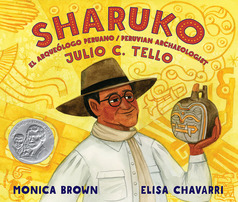Sharuko
Review
By Shelf Awareness
Monica Brown, Elisa Chavarri and Adriana Domínguez's accessible bilingual text, Sharuko, gives children access to the life of Julio C. Tello, "the first and greatest Indigenous archaeologist of Peru." As a boy, Julio dauntlessly searched for bones and skulls in the Andes Mountains. Because of his fearlessness, Julio was nicknamed Sharuko, or "brave," in Quechua, the Indigenous language of his tribe and the "language of the great Inca Empire." Sharuko first studied medicine, but his absorption in "the stories of his ancestors" and his attraction to the physical remnants of the past led him eventually to anthropology and archeology. He combined his formal study with his intimate knowledge of the language and people still living in Peru; his care in and devotion to re-creating Peruvian history made him an archeologist "still beloved by Peruvians." Both Brown and Chavarri are of Peruvian ancestry and express in notes that sharing this story was important to them. Chavarri's colorful watercolor and gouache paintings artistically and accurately depict Sharuko's discoveries of stone carvings at Chavín de Huántar, mummies and textiles in Paracas and his boyhood findings of skulls in Pariacaca. Chavarri's note mentions how her research influenced her renderings of the artifacts. Brown, who has written about many important Latinx figures (Frida Kahlo and Her Animalitos) succeeds again in making the passionate pursuit of a profession exciting for young readers. Domínguez's able Spanish translation of Brown's original English text allows this book to be enjoyed by a broader audience. Discover: A curious young Peruvian boy grows up to become a famous archeologist in this vibrant, bilingual picture book biography.







